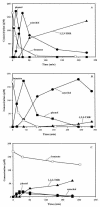Oxidation of benzene to phenol, catechol, and 1,2,3-trihydroxybenzene by toluene 4-monooxygenase of Pseudomonas mendocina KR1 and toluene 3-monooxygenase of Ralstonia pickettii PKO1
- PMID: 15240250
- PMCID: PMC444830
- DOI: 10.1128/AEM.70.7.3814-3820.2004
Oxidation of benzene to phenol, catechol, and 1,2,3-trihydroxybenzene by toluene 4-monooxygenase of Pseudomonas mendocina KR1 and toluene 3-monooxygenase of Ralstonia pickettii PKO1
Abstract
Aromatic hydroxylations are important bacterial metabolic processes but are difficult to perform using traditional chemical synthesis, so to use a biological catalyst to convert the priority pollutant benzene into industrially relevant intermediates, benzene oxidation was investigated. It was discovered that toluene 4-monooxygenase (T4MO) of Pseudomonas mendocina KR1, toluene 3-monooxygenase (T3MO) of Ralstonia pickettii PKO1, and toluene ortho-monooxygenase (TOM) of Burkholderia cepacia G4 convert benzene to phenol, catechol, and 1,2,3-trihydroxybenzene by successive hydroxylations. At a concentration of 165 microM and under the control of a constitutive lac promoter, Escherichia coli TG1/pBS(Kan)T4MO expressing T4MO formed phenol from benzene at 19 +/- 1.6 nmol/min/mg of protein, catechol from phenol at 13.6 +/- 0.3 nmol/min/mg of protein, and 1,2,3-trihydroxybenzene from catechol at 2.5 +/- 0.5nmol/min/mg of protein. The catechol and 1,2,3-trihydroxybenzene products were identified by both high-pressure liquid chromatography and mass spectrometry. When analogous plasmid constructs were used, E. coli TG1/pBS(Kan)T3MO expressing T3MO formed phenol, catechol, and 1,2,3-trihydroxybenzene at rates of 3 +/- 1, 3.1 +/- 0.3, and 0.26 +/- 0.09 nmol/min/mg of protein, respectively, and E. coli TG1/pBS(Kan)TOM expressing TOM formed 1,2,3-trihydroxybenzene at a rate of 1.7 +/- 0.3 nmol/min/mg of protein (phenol and catechol formation rates were 0.89 +/- 0.07 and 1.5 +/- 0.3 nmol/min/mg of protein, respectively). Hence, the rates of synthesis of catechol by both T3MO and T4MO and the 1,2,3-trihydroxybenzene formation rate by TOM were found to be comparable to the rates of oxidation of the natural substrate toluene for these enzymes (10.0 +/- 0.8, 4.0 +/- 0.6, and 2.4 +/- 0.3 nmol/min/mg of protein for T4MO, T3MO, and TOM, respectively, at a toluene concentration of 165 microM).
Figures


References
-
- Azerad, R. 2001. Editorial overview: better enzyme for green chemistry. Curr. Opin. Biotechnol. 12:533-534.
-
- Burton, S. G., A. Boshoff, W. Edwards, and P. D. Rose. 1998. Biotransformation of phenols using immobilised polyphenol oxidase. J. Mol. Catal. B Enzym. 5:411-416.
-
- Byrne, A. M., J. J. Kukor, and R. H. Olsen. 1995. Sequence analysis of the gene cluster encoding toluene-3-monooxygenase from Pseudomonas pickettii PKO1. Gene 154:65-70. - PubMed
Publication types
MeSH terms
Substances
Associated data
- Actions
- Actions
- Actions
LinkOut - more resources
Full Text Sources
Other Literature Sources
Molecular Biology Databases

